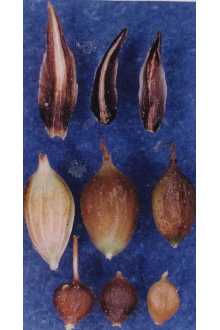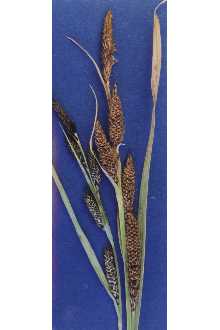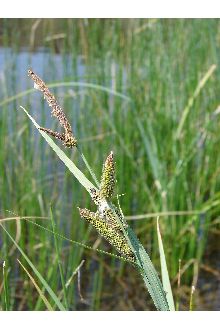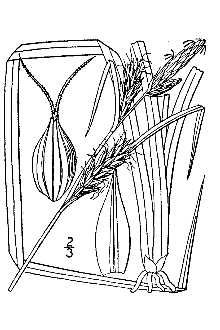Nebraska Sedge
Scientific Name: Carex nebrascensis Dewey
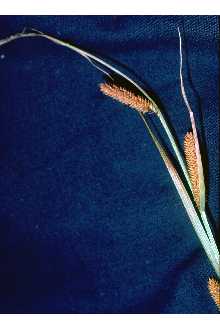
| General Information | |
|---|---|
| Usda Symbol | CANE2 |
| Group | Monocot |
| Life Cycle | Perennial |
| Growth Habits | Graminoid |
| Native Locations | CANE2 |
Plant Guide
Uses
Wildlife and Livestock: Nebraska sedge is a valuable forage species used by big game and livestock. The annual production and nutrient levels are quite high. It has half the protein level of alfalfa. It provides cover for nesting waterfowl, seeds for small mammals and birds, and muskrats and geese graze the shoots. It can be used as a key species to determine grazing pressure. It has moderate to good palatability early in the season, but becomes tough as the temperatures grow colder. Conservation Uses: This species has utility for erosion control, constructed wetland system applications, wildlife food and cover, wetland creation and restoration, and for increasing plant diversity in wetland and riparian communities. Its dense root mass (214 cm of roots/cm3 of soil) makes this species resistant to soil compaction and erosion. It also makes it an excellent choice for soil stabilization in wetland and riparian sites. Nebraska sedge is used extensively in bioengineering techniques, because of its root system. The rhizomes also form a matrix for many beneficial bacteria making this plant an excellent choice for wastewater treatment.
Status
Please consult the PLANTS Web site and your State Department of Natural Resources for this plant’s current status (e.g. threatened or endangered species, state noxious status, and wetland indicator values).
Description
General: Sedge Family (Cyperaceae). Nebraska sedge is a native, perennial, heavily rhizomatous wetland plant that is found in low valleys to mid-elevations. It will form dense stands, but more often, it is the dominant member of the wetland community. It grows in wet to moist meadows, marshes, swamps, ditches, seeps, stockwater ponds, low to moderate gradient streams, riparian wetlands, and lake shores. It reproduces by rhizomes and seed. However, seedling establishment is rare probably, because it needs freshly deposited, fertile, moist soil. Shoots from rhizomes are produced throughout the growing season and into late fall. It forms a dense deep root system with root biomass to 3000g/m2 in the top 20 cm of the soil. The stems are upright and triangular. The plants growing in saturated soils will grow to about 90 cm. The leaves are elongated, alternate, longer or shorter than the stem, up to 12 mm wide, and often with a bluish tinge. The flowers are borne in spikes. Male and female spikes are usually separate and on the same plant (monoecious). One or two male spikes are found above the female spikes. They are narrowly cylindrical and up to 5 cm long. Female spikes number from 2-5. They are 1-5 cm long and the lowest spike is subtended by a leafy bract. Plants flower in June to August. The fruits are brown lenticular achenes, up to 2 mm long. Seed ripens in August to September. They are surrounded by a "leathery capsule" called a perigynium. Perigynia are elliptic to ovate, 3 to 4 mm long, and yellowish brown to light brown in color. The seed (if present) is found in the base of the perigynial cavity. There are 2.7 million From Britton & Brown (1913) @ plants.usda.gov perigynia/kg. The perigynia is not held tightly in the seed head and high winds and frost will cause the perigynia to drop off. Distribution: Nebraska sedge is common throughout the western Midwest and western United States. For current distribution, please consult the Plant Profile page for this species on the PLANTS Web site.
Adaptation
It tolerates alkaline conditions very well, It is a wetland obligate plant, Nebraska sedge grows in areas that are saturated, It can handle standing water for long periods as long as there are periods where the soils dry, The sites where it is found rarely have the water table drop more than 1 m below the root zone late in the growing season, Use soil moisture sensors to measure the soil moisture of Nebraska Sedge., It can tolerate total inundation for about 3 months,
Seeds and Plant Production
Plant Production
Plant Production
Collection and cleaning: Seeds may be collected by hand striping the seed from the plant or clipping it using a pair of hand shears. A power seed harvester may also be used. The perigynia is often mistaken for the seed. In many cases, especially if there is a frost during flowering, the seed will not fill, but the perigynia will still form. It is recommended the collector open several perigynia to see if it actually contains a seed. If debris or other seed mixed in the collection, cleaning may be desirable. The hammer mill is used to break up the large debris and knock the seed loose from the stem. It may not always be needed. Cleaning can be accomplished using a seed cleaner with a No. 8 top screen and a No. 20 bottom screen. Screens should be sized so desired seed will fall through and debris and weed seed are removed. Air velocity should be adjusted so chaff and empty perigynia is blown away. Air flow and screen size may require adjustment to optimize cleaning process for given situation. Once the "seed" is cleaned, the perigynia must be removed. It can be removed with a seed scarifier or a sandpaper box. The seed is then re-cleaned using the top and bottom screens to separate the seed from the empty perigynia. Special procedures: The germination rate may be enhanced by removing the perigynia and by stratifying the seed in a mixture of water and sphagnum moss at 2° C for 30 days. Greenhouse Seeds need light, moisture, and heat for germination. Place seeds on surface of soil and press in lightly to assure good soil contact. Do not cover seed. Soil should be kept muddy. Greenhouse should be kept hot (32°C to 38°C). Germination should begin with in about one week. Maintain moisture until plants are to be transplanted. Wild transplants: Wild plants can be collected and transplanted directly into the desired project site. As long as no more than 4 dm squared and 13 to 15 cm deep is removed from any 1 m2 area, the hole will fill in within one growing season. Care should be taken not to collect plants from weedy areas as these weeds can be relocated to the transplant site and the hole left at the collection site may fill with undesirable species.
Establishment
Planting plugs (either from the greenhouse or wild transplants) is the surest way to establish a new stand of this species. Plug spacing of 30 to 45 cm will fill in within one growing season. The soil should be kept saturated with no more than 2.5 to 5.1 cm of standing water until the plants are well established and the aerenchymous material (the above ground biomass) is about 0.3 m tall. Fluctuating the water level during the establishment period may speed establishment and spread. Water levels can be managed to enhance rhizome spread and to control weeds.
Management
The soil should be kept saturated. The water table should rarely drop below the root zone. This species can tolerate periods of drought and total inundation. Water levels can be managed to control terrestrial weeds.
Pests and Potential Problems
Few insect or disease problems have been encountered in the greenhouse. Aphids will feed on the stems, but little or no damage has been noted and the vigor of the plant has not been affected. Cultivars, Improved, and Selected Materials (and area of origin) Contact your local Natural Resources
Conservation
Service (formerly Soil Conservation Service) office for more information. Look in the phone book under ”United States Government”. The Natural Resources Conservation Service will be listed under the subheading “Department of Agriculture.”
Fact Sheet
Uses
Nebraska sedge is suitable for erosion control, constructed wetland system applications, wildlife food and cover, wetland restoration and creation and improvement of plant diversity in wetland and riparian communities. Plants produce a dense root system (over 200 cm of roots /cm³ of soil) which makes this an excellent species for soil stabilization and bioengineering applications in wetland sites. Plants also have approximately half the protein level of alfalfa and are thus a valuable forage species for big game and livestock later in the growing season. Shoots are grazed by muskrat and geese, while seeds are eaten by small mammals and birds.
Status
Please consult the PLANTS Web site and your State Department of Natural Resources for this plant’s current status (e.g. threatened or endangered species, state noxious status, and wetland indicator values).
Description and Adaptation
Adaptation
Adaptation
Nebraska sedge is a perennial, strongly rhizomatous wetland plant that is found in low valleys to mid-elevations. It will form dense stands, and is often the dominant member of the wetland community. Stems are erect and triangular from 20 to 110 cm (8 to 43 in) tall. Leaves are alternate, up to 12 mm (0.5 in) wide and can be longer or shorter than the stem. Foliage is green or often a glaucus blue. Spikes can be pistillate, staminate or androgynous (staminate flowers above). The fruit is a light brown achene (2 mm long) surrounded by a perigynium. Perigynia are elliptic to ovate, 3 to 4 mm long and yellowish brown to light brown in color. Nebraska sedge is a commonly occurring wetland species found from Canada to Mexico and California to Illinois. Nebraska sedge is found in wet meadows, marshes, streams, ditches, seeps, ponds and lakes throughout the western U.S. Plants can handle standing water for long periods of time as long as there are periods when the soils are dry. Plants are best adapted to slightly acidic to somewhat alkaline conditions tolerating pH levels from 5.7 to 7.4. They are also tolerant of medium levels of salinity (EC<14).
Establishment
Germination can be enhanced by removing the perigynia and by wet pre-chilling the seeds in a mixture of water and sphagnum moss at 2º C (35º F) for 30 days, Seed requires light, moisture and heat for germination, For greenhouse propagation, place seed on soil surface and press in lightly to assure good soil contact, Use soil moisture sensors to measure the soil moisture of Nebraska Sedge., Do not cover seed, Soil should be kept moist, and the greenhouse should be kept hot, 32 to 38ºC (90 to 100º F), Germination should begin within one week, Maintain soil moisture until transplanting, Plugs should be transplanted at 30 to 45 cm (12 to 18 in) spacing, This allows plants to fill in within one growing season, Soils should be kept saturated with no more than 2,5 to 5 cm (1 to 2 in) of standing water at any time until the plants are well established and over 30 cm tall, Fluctuating water levels during the establishment year will facilitate spreading, Seed can be collected by hand stripping, clipping with hand shears or by using a gas powered seed stripper,
Management
Nebraska sedge grows in areas that are saturated. It can handle standing water for long periods of time as long as there are periods when the soils are dry. It is rarely found where the water table will drop more than 1 m below the root zone late in the growing season and can tolerate total inundation for about 3 months. Water levels can be managed to facilitate rhizome spread and control weeds.
Pests and Potential Problems
There are no known problems with insects or diseases. Aphids will feed on the stems, but rarely cause significant damage.
Environmental Concerns
These selected class releases are from a species native to the Intermountain West and have no known negative impacts on wild or domestic animals. Cultivars, Improved, and Selected Materials (and area of origin) The Aberdeen PMC has released four performance tested ecotypes of Nebraska sedge from the PMC service area. Centennial Selection was collected from the Centennial Marsh Wildlife Management Area (WMA) in Camas County, ID. It was selected for use in Land Resource Region (LRR) B West. The Modoc Selection was selected for use in LRR D North. It was collected from the Modoc National
Plant Traits
Growth Requirements
| Temperature, Minimum (°F) | -38 |
|---|---|
| Adapted to Coarse Textured Soils | Yes |
| Adapted to Fine Textured Soils | Yes |
| Adapted to Medium Textured Soils | Yes |
| Anaerobic Tolerance | High |
| CaCO3 Tolerance | Medium |
| Cold Stratification Required | Yes |
| Drought Tolerance | None |
| Fertility Requirement | Low |
| Fire Tolerance | High |
| Frost Free Days, Minimum | 85 |
| Hedge Tolerance | None |
| Moisture Use | High |
| pH, Maximum | 7.4 |
| pH, Minimum | 5.7 |
| Planting Density per Acre, Maxim | 4800 |
| Planting Density per Acre, Minim | 1700 |
| Precipitation, Maximum | 32 |
| Precipitation, Minimum | 14 |
| Root Depth, Minimum (inches) | 10 |
| Salinity Tolerance | Low |
| Shade Tolerance | Intolerant |
Morphology/Physiology
| After Harvest Regrowth Rate | Moderate |
|---|---|
| Toxicity | None |
| Resprout Ability | No |
| Shape and Orientation | Erect |
| Active Growth Period | Spring and Summer |
| Bloat | None |
| C:N Ratio | Medium |
| Coppice Potential | No |
| Fall Conspicuous | No |
| Fire Resistant | No |
| Flower Color | Green |
| Flower Conspicuous | No |
| Foliage Color | Gray-Green |
| Foliage Porosity Summer | Moderate |
| Foliage Porosity Winter | Porous |
| Fruit/Seed Color | Brown |
| Nitrogen Fixation | None |
| Low Growing Grass | No |
| Lifespan | Long |
| Leaf Retention | No |
| Known Allelopath | No |
| Height, Mature (feet) | 3.0 |
| Growth Rate | Moderate |
| Growth Form | Rhizomatous |
| Fruit/Seed Conspicuous | No |
| Foliage Texture | Medium |
Reproduction
| Vegetative Spread Rate | Moderate |
|---|---|
| Small Grain | No |
| Seedling Vigor | Low |
| Seed Spread Rate | Slow |
| Fruit/Seed Period End | Fall |
| Propagated by Tubers | No |
| Propagated by Sprigs | Yes |
| Propagated by Sod | No |
| Propagated by Seed | Yes |
| Propagated by Cuttings | No |
| Propagated by Container | No |
| Propagated by Bulb | No |
| Propagated by Bare Root | Yes |
| Fruit/Seed Persistence | No |
| Fruit/Seed Period Begin | Summer |
| Fruit/Seed Abundance | Medium |
| Commercial Availability | Routinely Available |
| Bloom Period | Late Spring |
| Propagated by Corm | No |
Suitability/Use
| Veneer Product | No |
|---|---|
| Pulpwood Product | No |
| Protein Potential | Medium |
| Post Product | No |
| Palatable Human | No |
| Palatable Graze Animal | High |
| Palatable Browse Animal | Medium |
| Nursery Stock Product | No |
| Naval Store Product | No |
| Lumber Product | No |
| Fodder Product | No |
| Christmas Tree Product | No |
| Berry/Nut/Seed Product | No |

